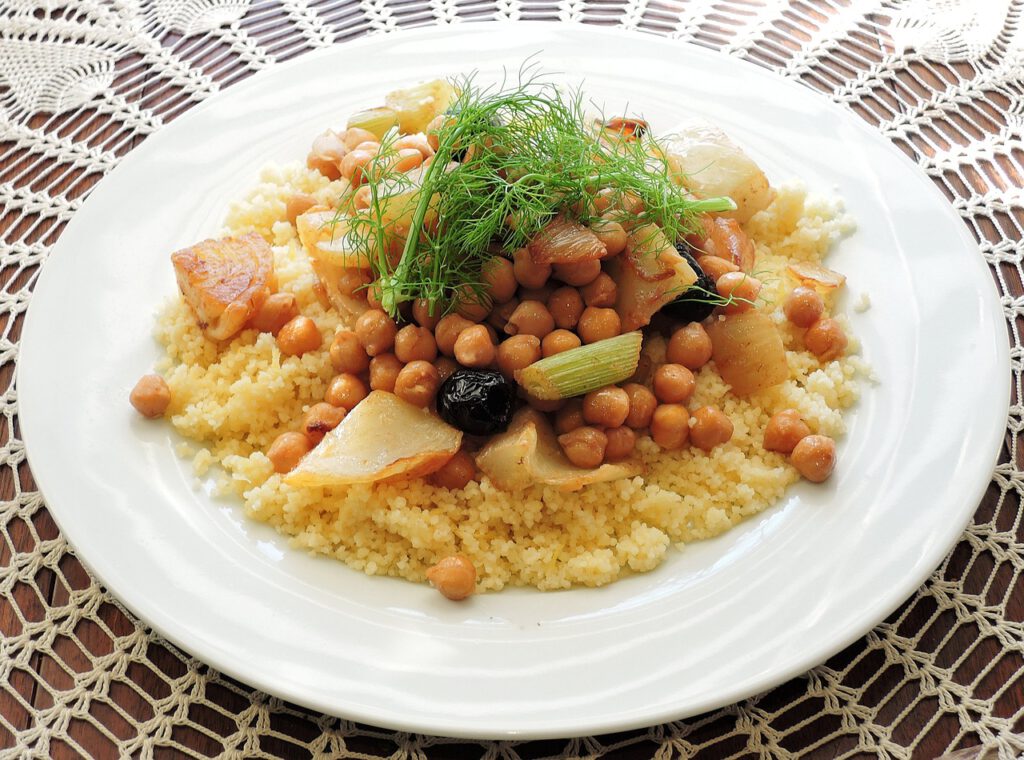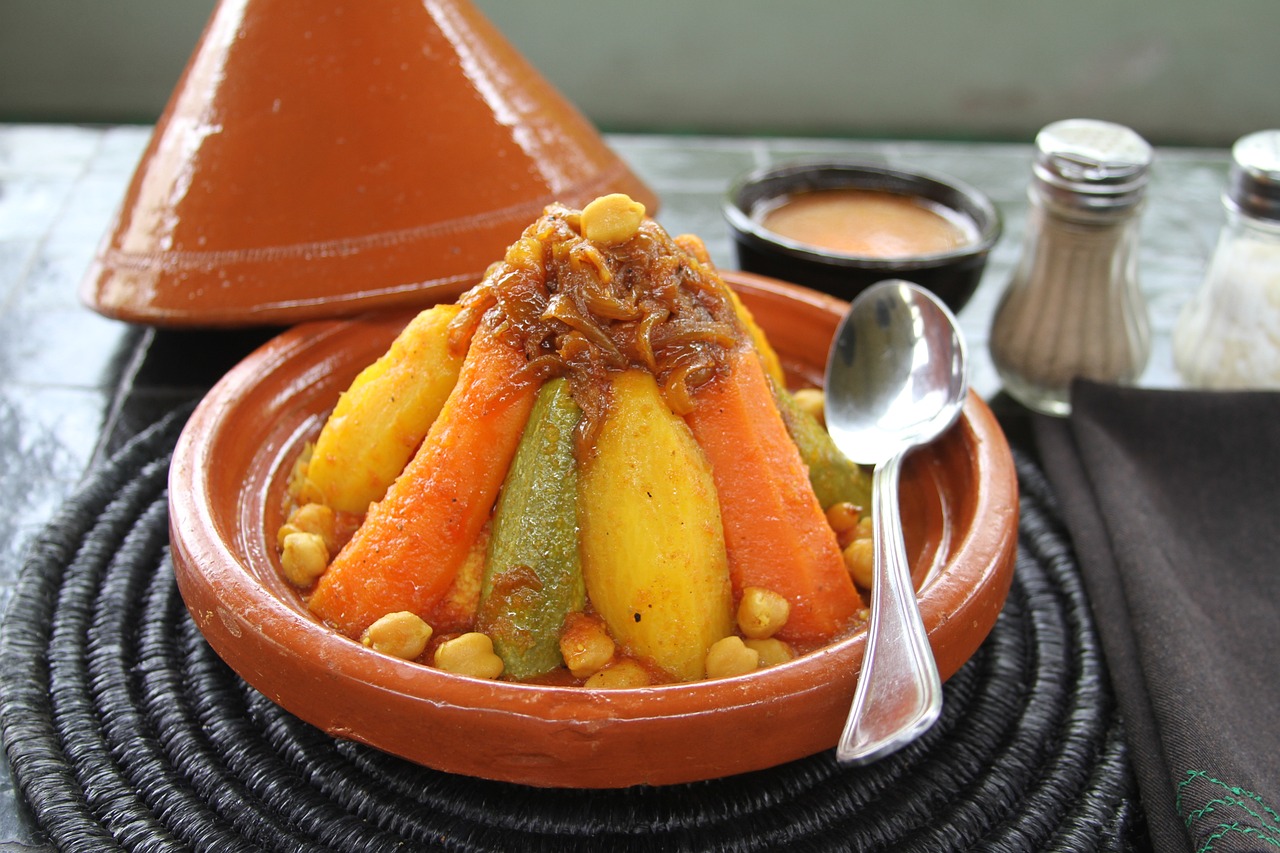From Tradition to Your Table
Moroccan couscous is more than just a dish; it’s a vibrant culinary experience steeped in tradition and culture. This staple of North African cuisine offers a unique blend of flavors, textures, and aromas that reflect the rich history of Morocco. In this detailed guide, we will explore the origins of Moroccan couscous, its preparation methods, and how you can recreate this delightful dish at home. Whether you’re a seasoned cook or a culinary novice, you’ll find this guide helpful and inspiring.
The Rich Heritage of Moroccan Couscous
A Historical Overview
Couscous, often hailed as the national dish of Morocco, has been a staple in North African cuisine for centuries. Its origins trace back to the Berber people, who first cultivated it in ancient times. The dish became a central part of Moroccan culture, symbolizing hospitality and family unity. Traditionally, couscous was prepared for special occasions and communal gatherings, highlighting its significance in Moroccan social life.
Cultural Significance
In Moroccan culture, couscous is more than just food; it represents tradition, unity, and celebration. The preparation of couscous is often a communal activity where families gather to cook and share meals. This cultural practice underscores the importance of family and community in Moroccan society. The dish is typically served with a variety of accompaniments, including meats, vegetables, and rich sauces, making it a versatile and celebratory meal.
Ingredients for Authentic Moroccan Couscous
Creating an authentic Moroccan couscous at home requires carefully selected ingredients. Here’s what you’ll need to capture the essence of this traditional dish:
- Couscous: The star ingredient, couscous is a type of steamed semolina wheat granules. It is the base of the dish and provides a light, fluffy texture.
- Vegetables: Traditional vegetables used include carrots, zucchini, and chickpeas. These add flavor, texture, and nutritional value to the dish.
- Meat: Lamb is a popular choice in Moroccan couscous, but chicken or beef can also be used. The meat is often slow-cooked to enhance its flavor.
- Spices: Moroccan cuisine is renowned for its aromatic spices. Key spices for couscous include cumin, coriander, cinnamon, and turmeric.
- Herbs: Fresh herbs like cilantro and parsley add a burst of freshness and color.
- Onions and Garlic: Essential for building a flavorful base, onions and garlic provide depth to the dish.
- Raisins and Almonds: For a touch of sweetness and crunch, raisins and almonds are commonly added.
- Stock: Chicken or vegetable stock is used to cook the couscous and infuse it with rich flavor.
Step-by-Step Recipe for Moroccan Couscous
Ingredients
- 1 cup couscous
- 2 tablespoons olive oil
- 1 onion, finely chopped
- 3 garlic cloves, minced
- 1 teaspoon ground cumin
- 1 teaspoon ground coriander
- 1/2 teaspoon ground cinnamon
- 1/2 teaspoon turmeric
- 1 cup chopped carrots
- 1 cup chopped zucchini
- 1 cup chickpeas (canned or cooked)
- 1/2 cup raisins
- 1/4 cup sliced almonds
- 2 cups chicken or vegetable stock
- 1 bunch fresh cilantro, chopped
- 1 bunch fresh parsley, chopped
- Salt and pepper to taste
Instructions
Step 1: Prepare the Couscous
- Measure and Cook: Start by measuring 1 cup of couscous into a large bowl. In a separate saucepan, bring 2 cups of chicken or vegetable stock to a boil. Once boiling, pour the stock over the couscous. Cover the bowl with a lid or plastic wrap and allow it to rest for 5 minutes.
- Fluff the Couscous: After 5 minutes, remove the cover and use a fork to fluff the couscous, separating any clumps. Drizzle with 2 tablespoons of olive oil and mix to incorporate. Set aside.
Step 2: Prepare the Meat and Vegetables
- Cook the Meat: Heat a large pot or Dutch oven over medium heat. Add 2 tablespoons of olive oil and sauté the finely chopped onion and minced garlic until they are soft and fragrant. Add the meat (lamb, chicken, or beef) and brown on all sides.
- Add Spices: Stir in the ground cumin, ground coriander, ground cinnamon, and turmeric. Cook for 2-3 minutes to toast the spices and enhance their flavor.
- Add Vegetables and Stock: Add the chopped carrots, zucchini, and chickpeas to the pot. Pour in 2 cups of chicken or vegetable stock and bring to a simmer. Cover and cook for 30-40 minutes, or until the meat and vegetables are tender.
Step 3: Combine and Serve
- Incorporate Raisins and Almonds: Stir in the raisins and sliced almonds. Continue cooking for an additional 5 minutes to allow the flavors to meld.
- Mix with Couscous: Gently fold the cooked couscous into the meat and vegetable mixture. Ensure that the couscous is evenly distributed and well mixed with the flavorful sauce.
- Garnish and Serve: Garnish with freshly chopped cilantro and parsley. Season with salt and pepper to taste. Serve hot and enjoy the delightful blend of flavors.
Tips for Perfect Moroccan Couscous
Quality Ingredients
For the best results, use high-quality couscous and fresh, organic vegetables. The quality of the ingredients can greatly impact the flavor and texture of the final dish.
Customizing the Dish
Feel free to customize your Moroccan couscous by adding your favorite vegetables or adjusting the spice levels to suit your taste. You can also experiment with different types of meat or even make a vegetarian version using a variety of legumes.
Storage and Reheating
Leftover couscous can be stored in an airtight container in the refrigerator for up to 3 days. To reheat, add a splash of water or broth and gently reheat in a skillet or microwave.
Exploring Moroccan Couscous Variations
Sweet and Savory Couscous
For a sweet and savory twist, consider adding dried fruits like apricots or dates. These add a delightful contrast to the savory elements of the dish.
Seafood Couscous
In coastal regions of Morocco, seafood couscous is a popular variation. Substitute fish or shrimp for the traditional meat and add seafood-friendly spices like paprika and saffron.
Vegetarian Couscous
For a hearty vegetarian option, increase the amount of chickpeas and add a variety of vegetables. A combination of bell peppers, sweet potatoes, and green beans works wonderfully.

The Global Appeal of Moroccan Couscous
Moroccan couscous has transcended its traditional roots to become a beloved dish worldwide. Its versatility and rich flavors have earned it a place in diverse culinary traditions. From Moroccan restaurants to home kitchens across the globe, couscous continues to enchant and satisfy.
Nutritional Benefits
Moroccan couscous offers numerous health benefits. It is a good source of fiber, essential vitamins, and minerals. The combination of vegetables, legumes, and lean meat provides a balanced and nutritious meal.
A Dish for Every Occasion
Whether you’re hosting a dinner party, preparing a family meal, or simply enjoying a weeknight dinner, Moroccan couscous is a versatile dish that fits any occasion. Its ability to be both elegant and comforting makes it a favorite among many.
Conclusion
Moroccan couscous is more than just a meal; it’s a celebration of culture, tradition, and flavor. By understanding its rich history and learning how to prepare it authentically, you can bring a taste of Morocco into your kitchen. With this comprehensive guide, you are now equipped to create a delicious and memorable Moroccan couscous that will impress and satisfy. Enjoy the process of cooking, and savor the delightful experience of this traditional North African dish.

